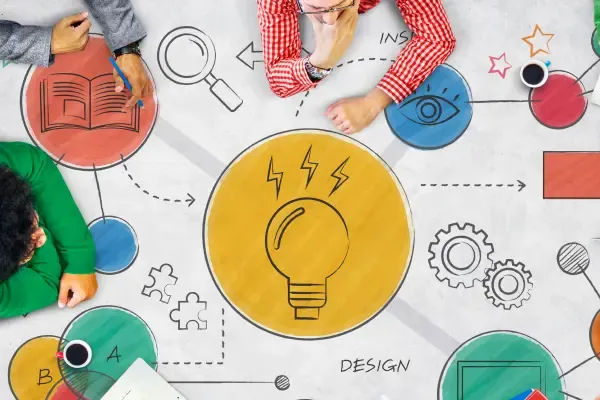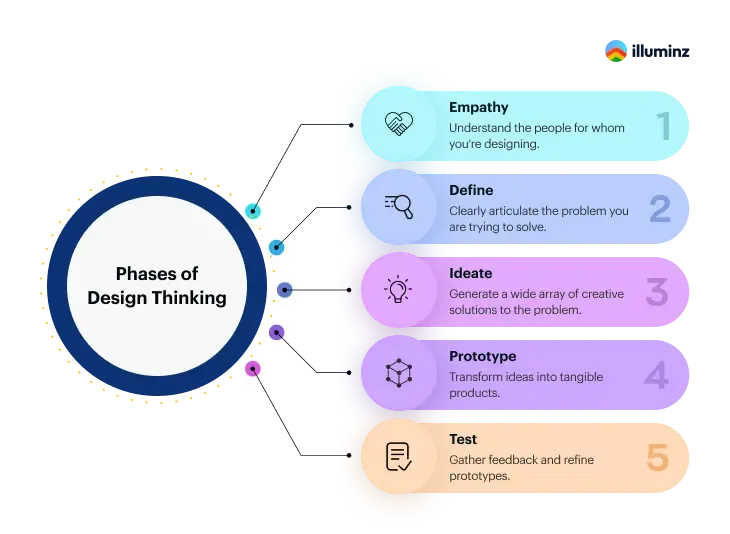
Introduction
Ever found a product that seemed made just for you? That's Design Thinking at work.
It's where empathy meets innovation, crafting solutions tailor-made for real needs.
Let's dive into this creative process, shaping how today's business challenges and opportunities are tackled.
Understanding of Design Thinking
A user-centric approach that unlocks creativity and innovation in solving complex challenges, design thinking is for everyone – from designers to business strategists and engineers. At its core, design thinking involves a deep dive into understanding users or customers — identifying their needs and challenges, and innovating in ways that resonate meaningfully.
For instance, take Bank of America's 'Keep the Change' program. They wanted to help customers save money easily. By deeply understanding their customers' needs and behaviors, they designed and developed a program that rounded up purchases to the nearest dollar and automatically saved the difference. This simple, empathetic solution transformed the way people saved, making it effortless and effective.

Phases of Design Thinking

Imagine design thinking as a journey with five distinct but interconnected stops. It's a path of discovery, where each phase contributes to a deeper understanding of user needs and innovative problem-solving:
1) Empathy: The Heart of Design
This phase is all about understanding the people you're designing for. You'll dive deep into their world through observation, interaction, and immersing yourself in their experiences. The goal is to gather insights into their needs, desires, and pain points, which will guide the entire design process.
2) Define: The Map to Your Destination
In the Define phase, you'll take what you've learned about your users and identify the core problems you aim to solve. This is where you analyze your observations and synthesize them into a clear, actionable problem statement. It's about bringing clarity and focus to the design space.
3) Ideate: Unleashing Your Creative Storm
Now it's time to think outside the box. Ideation is the brainstorming phase where you generate a wide variety of ideas and explore different solutions. The aim is to go for quantity and creativity, pushing the boundaries of what's possible and looking at the problem from various angles.
4) Prototype: Turning Ideas into Reality
Here, you start bringing your ideas to life with tangible representations. Prototypes can range from simple sketches to interactive digital models. This phase is about experimentation and iteration; you'll create, test, and refine your concepts, learning what works and what doesn't along the way.
5) Test: Learning by Doing
The final phase is all about validation. You'll test your prototypes with real users, observing and listening to their feedback. This is a critical step for understanding the effectiveness of your solutions and making necessary adjustments. Testing can reveal new insights, which might lead you back to earlier phases for further refinement.
Each of these phases is crucial in the design thinking process, contributing to the development of solutions that are not only innovative but also deeply rooted in the real needs and desires of the users.
How Design Thinking Enhances Customer Experience
As we know Design thinking significantly enhances the customer experience by placing the customer's needs, desires, and behaviors at the forefront of product and service development. Here's how this approach transforms the customer journey into something exceptional:

Mastering the Challenges of Design Thinking
It involves understanding and overcoming the common hurdles that can arise during the process. Here's how you can navigate these challenges effectively-
- Getting Comfortable with Uncertainty: Design thinking often starts with not knowing the exact problem. It's like being okay with exploring a new city without a map, ready to discover as you go.
- Mixing Creative and Practical: You'll think up lots of wild ideas, but they also need to make sense in the real world. It's like dreaming big but also keeping your feet on the ground.
- Working Together Well: Design thinking needs everyone to chip in and share ideas. It's about making sure everyone, no matter their job title, feels they can speak up and contribute.
- Embracing New Ideas: People often don't like change, so when you bring up new ideas, there might be some pushback. It's about showing how these new ideas help everyone and celebrating small successes to win people over.
- Keeping an Eye on Time and Money: These projects can take a lot of time and resources. It's important to plan well, set clear goals, and keep everyone focused so you don't run over time or budget.
- Staying Close to Your Users: It can be hard to get real users to test your ideas or give feedback. Try different ways to hear from them, like surveys or quick chats, so you really build something they need.
- Learning from Mistakes: Not every idea will work out, and that's okay. Think of mistakes as lessons that help you get better and closer to a great solution.
Understanding these challenges and how to tackle them can make your design-thinking journey smoother and more successful.
Pioneering the Future with Design Thinking
Pioneering the future with design thinking is about boldly stepping into the unknown with a creative and empathetic mindset. This approach doesn't just solve current problems; it anticipates and shapes what's to come.
It involves deeply understanding people's needs today to predict and innovate for tomorrow, creating solutions that are not just technologically advanced but also deeply human. By embracing change, fostering a culture of innovation, and leveraging emerging technologies, design thinking helps break down barriers between departments, encouraging diverse perspectives to address complex challenges.
It's about crafting personalized, sustainable solutions that adapt and evolve. As we look to the future, design thinking is more than a process; it's a way of seeing the world, a strategy for resilience, and a commitment to building a better, more adaptable tomorrow. It's not just about making things; it's about making things possible.
Conclusion
In conclusion, design thinking isn't just a process; it's a journey towards more thoughtful, user-centered solutions like Bank of America's 'Keep the Change' program. This approach combines empathy, creativity, and practicality to meet real human needs. As you apply design thinking to your challenges, remember it's about more than solving problems—it's about enhancing lives and pioneering a future where every solution is as human as it is innovative. Embrace this mindset, and you'll not only find better answers but also create experiences that truly resonate.
Frequently Asked Questions on Design Thinking
Question 1: Why is empathy important in Design Thinking?
Answer 1: Empathy allows designers to understand the user's experience deeply, leading to solutions that truly address their needs and improve their lives.
Question 2: What are some common challenges in Design Thinking?
Answer 2: Common challenges include dealing with uncertainty, balancing creativity with feasibility, and ensuring continual user involvement and feedback.
Question 3: Can Design Thinking be used for complex problems?
Answer 3: Absolutely. Design thinking is especially effective for tackling complex, ambiguous problems by breaking them down into manageable parts and focusing on the user.

